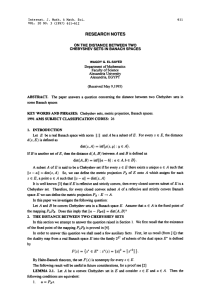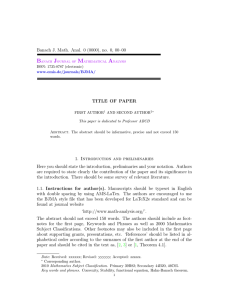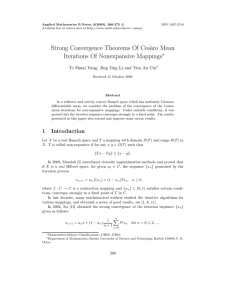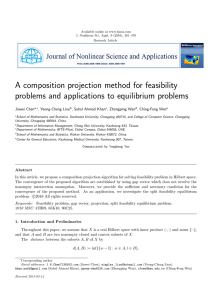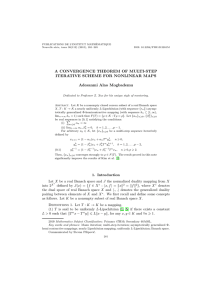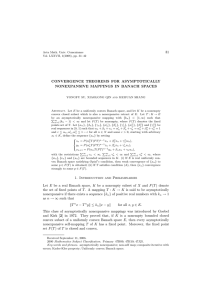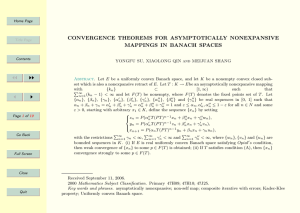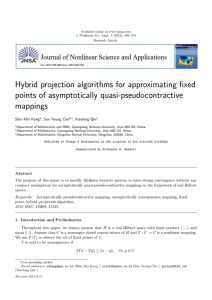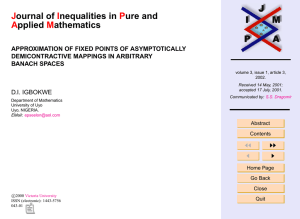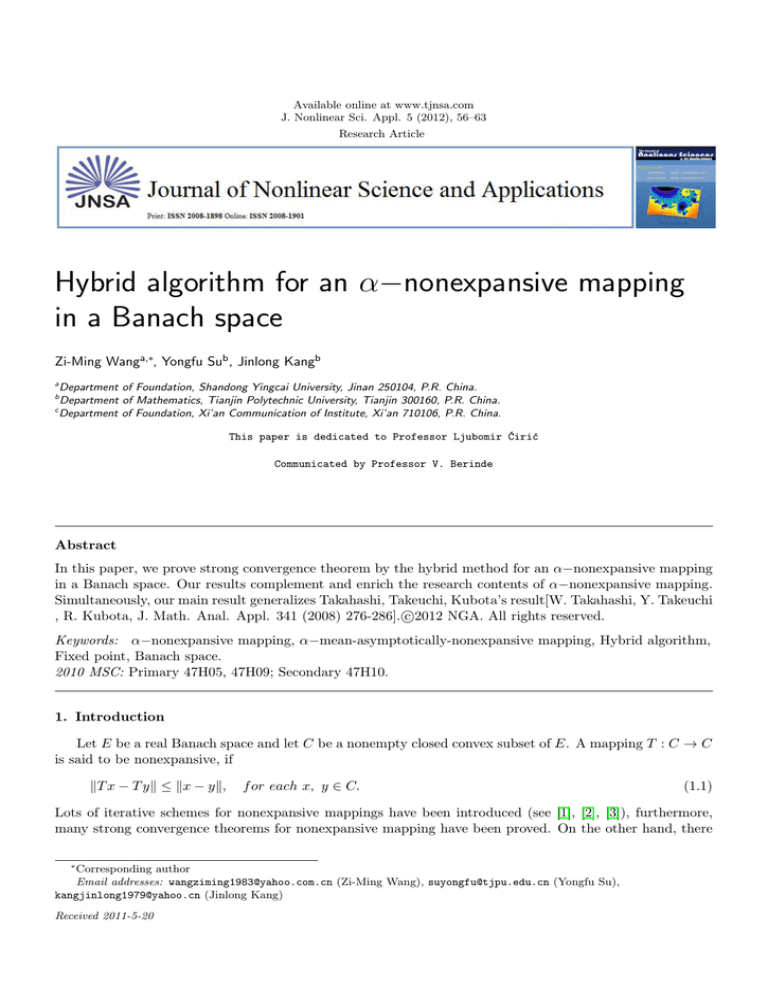
Available online at www.tjnsa.com
J. Nonlinear Sci. Appl. 5 (2012), 56–63
Research Article
Hybrid algorithm for an α−nonexpansive mapping
in a Banach space
Zi-Ming Wanga,∗, Yongfu Sub , Jinlong Kangb
a
Department of Foundation, Shandong Yingcai University, Jinan 250104, P.R. China.
Department of Mathematics, Tianjin Polytechnic University, Tianjin 300160, P.R. China.
c
Department of Foundation, Xi’an Communication of Institute, Xi’an 710106, P.R. China.
b
This paper is dedicated to Professor Ljubomir Ćirić
Communicated by Professor V. Berinde
Abstract
In this paper, we prove strong convergence theorem by the hybrid method for an α−nonexpansive mapping
in a Banach space. Our results complement and enrich the research contents of α−nonexpansive mapping.
Simultaneously, our main result generalizes Takahashi, Takeuchi, Kubota’s result[W. Takahashi, Y. Takeuchi
c
, R. Kubota, J. Math. Anal. Appl. 341 (2008) 276-286].2012
NGA. All rights reserved.
Keywords: α−nonexpansive mapping, α−mean-asymptotically-nonexpansive mapping, Hybrid algorithm,
Fixed point, Banach space.
2010 MSC: Primary 47H05, 47H09; Secondary 47H10.
1. Introduction
Let E be a real Banach space and let C be a nonempty closed convex subset of E. A mapping T : C → C
is said to be nonexpansive, if
kT x − T yk ≤ kx − yk,
f or each x, y ∈ C.
(1.1)
Lots of iterative schemes for nonexpansive mappings have been introduced (see [1], [2], [3]), furthermore,
many strong convergence theorems for nonexpansive mapping have been proved. On the other hand, there
∗
Corresponding author
Email addresses: wangziming1983@yahoo.com.cn (Zi-Ming Wang), suyongfu@tjpu.edu.cn (Yongfu Su),
kangjinlong1979@yahoo.cn (Jinlong Kang)
Received 2011-5-20
Z.-M. Wang, Y. Su, J. Kang, J. Nonlinear Sci. Appl. 5 (2012), 56–63
57
are many nonlinear mappings which are more general than the nonexpansive mapping. Compare to the exist
problem of fixed point of those mapping, the iterative methods for finding fixed point is also very useful in
studying in the fixed point theory and the theory of equations in other fields.
In 2007, Gobel and Pineda [4] introduced and studied a new mapping, called α−nonexpansive mapping.
The mapping is more general than the nonexpansive one.
Definition
1.1. For a given multiindex α = (α1 , α2 , · · ·, αn ) satisfies αi ≥ 0, i = 1, 2, · · ·, n and
Pn
i=1 αi = 1. A mapping T : C → C is said to be α−nonexpansive if
n
X
αi kT i x − T i yk ≤ kx − yk,
∀ x, y ∈ C.
(1.2)
i=1
In order to show that the class of α−nonexpansive mapping is more general than the one of nonexpansive
mappings, we give an example.
Example 1.2. Let E = R1 , and
(
0,
if
x = 0;
T (x) = 1
if
x ∈ (0, +∞).
x,
Then, T is not nonexpansive but α−nonexpansive.
Proof. Obviously, T is not nonexpansive. Taking x = 21 , y = 0, by the definition of T x, we have
1
kT x − T yk = |2 − 0| > | − 0| = kx − yk.
2
On the other hand, for every x, y ∈ [0, +∞), we have
kT 2 x − T 2 yk = kx − yk.
Therefore, we can affirm that
0kT x − T yk + kT 2 x − T 2 yk = kx − yk
where α = (α1 , α2 ) = (0, 1). Then T is an α−nonexpansive mapping but not a nonexpansive one. If T is nonexpansive self-mapping, we can imply that T must be α−nonexpansive one, where α =
(α1 , α2 , · · ·, αn ) = ( n1 , n1 , · · ·, n1 , ).
For technical reason we always assume that the first coefficient α1 is nonzero, that is, α1 > 0. In this
case the mapping T satisfies the Lipschitz condition
kT x − T yk ≤
1
kx − yk,
α1
∀ x, y ∈ C.
(1.3)
Recall a mapping T : C → C is said to be an asymptotically nonexpansive mapping, if exists a sequence of
reals {γn } with 0 ≤ γn → 0 such that
kT n x − T n yk ≤ (1 + γn )kx − yk,
∀ x, y ∈ C.
Noticing that, with regard to (1.4), take n = 1, 2, · · ·, n, we have
kT x − T yk ≤ (1 + γ1 )kx − yk,
kT 2 x − T 2 yk ≤ (1 + γ2 )kx − yk,
···
(1.4)
Z.-M. Wang, Y. Su, J. Kang, J. Nonlinear Sci. Appl. 5 (2012), 56–63
58
kT n x − T n yk ≤ (1 + γn )kx − yk.
By multiplying the above inequalities with αi ≥ 0, i = 1, 2, · · ·, n, respectively, we have
α1 kT x − T yk ≤ α1 (1 + γ1 )kx − yk = α1 kx − yk + α1 γ1 kx − yk,
α2 kT 2 x − T 2 yk ≤ α2 (1 + γ2 )kx − yk = α2 kx − yk + α2 γ2 kx − yk,
···
αn kT n x − T n yk ≤ αn (1 + γn )kx − yk = αn kx − yk + αn γn kx − yk.
Adding all the inequalities above, we obtain
n
X
αi kT i x − T i yk ≤
i=1
Since
αi kx − yk +
i=1
Pn
i=1 αi
n
X
n
X
n
X
αi γi kx − yk.
i=1
= 1 and suppose that limn→∞
Pn
i=1 αi γi
= 0, we have
αi kT i x − T i yk ≤ (1 + λn )kx − yk,
(1.5)
i=1
where λn =
Pn
i=1 αi γi .
Definition
1.3. For a given multiindex α = (α1 , α2 , · · ·, αn ) satisfies αi ≥ 0, i = 1, 2, · · ·, n and
Pn
α
=
1.
A mapping T : C → C is said to be α−mean-asymptotically-nonexpansive if exists a sequence
i=1 i
of reals {λn } with 0 ≤ λn → 0 such that
n
X
αi kT i x − T i yk ≤ (1 + λn )kx − yk.
i=1
Remark 1.4. From the analysis above and Definition 1.1 , we know that each α−nonexpansive mapping is
an α−mean-asymptotically-nonexpansive one.
The last observation is that (1.2) implies that for α = (α1 , α2 , · · ·, αn ) the mapping
Tα x =
n
X
αi T i x, ∀ x ∈ C
(1.6)
i=1
is nonexpansive. However, nonexpansiveness of Tα is much weaker than (1.2), for instance, it doesn’t entail
the continuity of T (see [4]).
Recently, Chakkrid Klin-eam, Suthep Suantai[5], introduced the relation of the fixed point sets between
α−nonexpasive operator and Tα operator. they give the following theorem:
Theorem 1.5. (see Theorem 3.1 of Klin-eam, Suantai [5]) Let C be a closed convex subset of a Banach
space E and for all n ∈ N, let α = (α1 , α2 , · · ·, αn ) such that αi ≥ 0, i = 1, 2, · · ·, n, α1 > 0 and
P
n
1√
i=1 αi = 1. Let T be an α−nonexpansive mapping from C into itself. If α1 > n−1 2 , then F (T ) = F (Tα ),
where F (T ) is the fixed point set of T .
At the same time, they have succeeded in proving the demiclosedness principle for the α−nonexpansive
mappings.
Z.-M. Wang, Y. Su, J. Kang, J. Nonlinear Sci. Appl. 5 (2012), 56–63
59
Theorem 1.6. (see Theorem 3.4 of Klin-eam, Suantai [5]) Let C be a closed convex subset of a Banach
space
Pn E and for all n ∈ N, let α = (α1 , α2 , · · ·, αn ) such that αi ≥ 0, i = 1, 2, · · 1·, n, α1 > 0 and
√
i=1 αi = 1. Let T be an α−nonexpansive mapping from C into itself with α1 > n−1 2 , if {xn } ⊂ C
converges weakly to x and {xm − T xm } converges strongly to 0 as n → ∞, then x ∈ F (T ).
Motivated by results above, we prove strong convergence theorems by the hybrid method for an α−nonexpansive
mapping in a Banach space.
2. Preliminaries
In what follows, E denotes a real Banach space with norm k · k and E ∗ the dual space of E. The norm
of E ∗ is also denoted byk · k. For x∗ ∈ E ∗ , its value at x ∈ E is denoted by hx, x∗ i. The normalized duality
mapping J from E to E ∗ is defined by
J(x) = {x∗ ∈ E ∗ : hx, x∗ i = kxk2 = kx∗ k2 }
(2.1)
for all x ∈ E. Some properties of the duality mapping have been given in [6, 7].
A Banach space E is said to be strictly convex if kx + yk < 2 for all x, y ∈ E with kxk = kyk = 1 and
x 6= y. A Banach space E is also said to be uniformly convex if limn→∞ kxn − yn k = 0 for any two sequences
{xn } and {yn } in E such that kxn k = kyn k = 1 and limn→∞ kxn + yn k = 2. We also know that if E is a
uniformly convex Banach space, then xn * x and kxn k → kxk imply xn → x. Let U = {x ∈ E : kxk = 1}
be the unit sphere of E, then the Banach space E is said to be smooth if
kx + tyk − kxk
n→∞
t
lim
exists for each x, y ∈ U .
Let C be a nonempty closed convex subset of a smooth, strictly convex, and reflexive Banach space E.
Then, for arbitrarily fixed x ∈ E, a function C 3 ky − xk ∈ R has a unique minimizer yx ∈ C. Using such
a point, we define the metric projection PC by PC x = yx = argminy∈C kx − yk2 for every x ∈ E. In a
similar fashion, we can see that a function C 3 y 7→ φ(x, y) ∈ R also has a unique minimizer zx ∈ C. The
generalized projection ΠC of E onto C is defined by ΠC x = zx = argminy∈C φ(x, y) for every x ∈ E; see [8].
In fact, we have the following result.
Lemma 2.1. (see [8]) Let C be a nonempty closed and convex subset of a real reflexive, strictly convex, and
smooth Banach space E and let x ∈ E. Then, there exists a unique element x0 ∈ C such that φ(x0 , x) =
min{φ(z, x) : z ∈ C}.
In order to prove our results, the following lemmas are needed.
Lemma 2.2. (see [8]) Let C be a nonempty closed and convex subset of a real smooth Banach space E, Let
x ∈ E. Then, x0 = ΠC x if and only if
hz − x0 , Jx0 − Jxi ≥ 0,
∀z ∈ C.
In Chakkrid Klin-eam, Suthep Suantai [5], they also give the following lemma:
Lemma 2.3. (see Lemma 3.3 of Klin-eam, Suantai [5]) Let C be a closed convex subset of a Banach
space
Pn
E and for all n ∈ N, let α = (α1 , α2 , · · ·, αn ) such that αi ≥ 0, i = 1, 2, · · ·, n, α1 > 0 and i=1 αi = 1.
1√
Let T be an α−nonexpansive mapping from C into itself. If α1 > n−1
. Let {xm } be a bounded sequence in
2
C, then kxm − T xm k → 0 if and only if kxm − Tα xm k → 0 as m → ∞.
A mapping T : C → C is said to be closed, if for any sequence {xn } ⊂ C with xn → x and T xn → y,
then T x = y.
Z.-M. Wang, Y. Su, J. Kang, J. Nonlinear Sci. Appl. 5 (2012), 56–63
60
Lemma 2.4. Let C be a closed convex subset of P
a Banach space E and for all n ∈ N, let α = (α1 , α2 , ···, αn )
such that αi ≥ 0, i = 1, 2, · · ·, n, α1 > 0 and ni=1 αi = 1. Let T be an α−nonexpansive mapping from C
1√
into itself. If α1 > n−1
. Let {xm } ⊂ C converges strongly to x and {xn − T xm } converges strongly to 0 as
2
n → ∞, then x ∈ F (T ).
Proof. Since {xn − T xm } converges strongly to 0 as n → ∞, from Lemma 2.3, we have {xm − Tα xm }
converges stronglly to 0 as n → ∞. Since Tα is a nonexpansive mapping, which is closed. We have
x ∈ F (Tα ). From Theorem 1.5, we obtain that x ∈ F (T ). Lemma 2.5. Let C be a uniformly convex and smooth Banach
space E and for all n ∈ N, let α = (α1 , α2 , ··
P
·, αn ) such that αi ≥ 0, i = 1, 2, · · ·, n, α1 > 0 and ni=1 αi = 1. Let T be an α−nonexpansive mapping
1√
from C into itself. If α1 > n−1
. Then F (T ) is closed and convex.
2
Proof. By Theorem 1.5, we have F (T ) = F (Tα ). Since Tα is a nonexpansive mapping, we know that F (Tα )
is closed and convex here. So, with regard to an α−nonexpansive T , we also have that F (T ) is closed and
convex. 3. The Main Result
In this section, we consider a strong convergence theorem for an α−nonexpansive operator in a Banach
space.
Theorem 3.1. Let C be a closed convex subset of a uniformly convex and
P smooth Banach space E. Let
α = (α1 , α2 , · · ·, αn ) such that αi ≥ 0, i = 1, 2, · · ·, n, α1 > 0 and ni=1 αi = 1, let T : C → C be
an α−nonexpansive mapping such that F (T ) 6= ∅. For x0 ∈ E, C1 = C and x1 = ΠC1 x0 , define a sequence
{xn } of C as follows:
yn = (1 − βn )xn + βn T xn ,
(3.1)
Cn+1 = {z ∈ Cn : kyn − zk ≤ kxn − zk},
xn+1 = ΠCn+1 x0 , n ∈ N,
where 0 < a ≤ βn ≤ 1, for all n ∈ N. If α1 >
1
√
n−1
2
, Then, xn converges strongly to z0 = ΠF (T ) x0 .
Proof. Firstly, we show that Cn is closed and convex and F (T ) ⊂ Cn for every n ∈ N
It is obvious that Cn is closed, for every n ∈ N. It follows that Cn is convex for every n ∈ N. Since
kyn − zk ≤ kxn − zk
(3.2)
is equivalent to
kyn − xn k2 + 2hyn − xn , Jxn − Jzi ≤ 0.
(3.3)
So, Cn is convex for every n ∈ N. For u ∈ F (T ), we compute that
kyn − uk = k(1 − βn )xn + βn T xn − uk
≤ (1 − βn )kxn − uk + βn kT xn − uk
= (1 − βn )kxn − uk + βn kT xn − Tα uk
= (1 − βn )kxn − uk + βn kα1 (T xn − T u)
+ α2 (T xn − T 2 u) + · · · + αn (T xn − T n u)k
≤ (1 − βn )kxn − uk + βn
1 − α1n−1
kxn − T uk
α1n−1
≤ (1 − βn )kxn − uk + βn kxn − uk
= kxn − uk.
(3.4)
Z.-M. Wang, Y. Su, J. Kang, J. Nonlinear Sci. Appl. 5 (2012), 56–63
61
It implies that u ∈ Cn , for each n ∈ N. So, we have F (T ) ⊂ Cn for all n ∈ N.
Next, we prove that {x} is bounded. Since F (T ) is a nonempty closed convex subset of C, there exists
a unique element z0 ∈ F (T ) such that z0 = ΠF (T ) x0 . From xn+1 = ΠCn+1 x0 , we have
kxn+1 − x0 k ≤ kz − x0 k,
(3.5)
for every z ∈ Cn+1 . As z0 ∈ F (T ) ⊂ Cn+1 , we obtain
kxn+1 − x0 k ≤ kz0 − x0 k,
(3.6)
for every n ∈ N. This implies that {xn } is bounded.
On the other hand, Cn+1 ⊂ Cn for all n ∈ N, we have
xn+1 = ΠCn+1 x0 ∈ Cn+1 ⊂ Cn ,
for all n ∈ N. Since xn = ΠCn x0 , we obtain that
kxn − x0 k ≤ kxn+1 − x0 k,
(3.7)
for all n ∈ N. It follows from (3.6) that the limit of {xn − x0 } exists.
Since Cm ⊂ Cn , xm+1 = ΠCm+1 x0 ∈ Cm ⊂ Cn for all m ≥ n and xm+1 = ΠCm+1 x0 , in view of Lemma
2.1, one has
hxn+1 − x0 , Jxn+1 − Jxn+1 i ≥ 0.
(3.8)
We compute that
kxm+1 − xn+1 k2 = kxm+1 − x0 − (xn+1 − x0 )k2
= kxm+1 − x0 k2 + kxn+1 − x0 k2 − 2hxn+1 − x0 , Jxm+1 − Jx0 i
= kxm+1 − x0 k2 + kxn+1 − x0 k2
− 2hxn+1 − x0 , Jxm+1 − Jxn+1 + Jxn+1 − Jx0 i
= kxm+1 − x0 k2 − kxn+1 − x0 k2 − 2hxn+1 − x0 , Jxm+1 − Jxn+1 i
≤ kxm+1 − x0 k2 − kxn+1 − x0 k2 .
Since the limit of kxn+1 − x0 k exists, we get
lim kxm − xn k = 0.
(3.9)
n→∞
Therefore, {xn } is a Cauchy sequence. Since Banach space is a complete metric space and C is closed and
convex, one can assume that
xn → p,
as n → ∞.
(3.10)
Noticing that xn+1 = ΠCn+1 x0 ∈ Cn+1 , we obtain that
kyn − xn+1 k ≤ kxn − xn+1 k.
(3.11)
In view of (3.10), we have that
kyn − xn+1 k → 0,
as n → ∞
(3.12)
and
kyn − xn k ≤ kyn − xn+1 k + kxn+1 − xn k → 0,
as n → ∞.
(3.13)
From yn = (1 − βn )xn + βn T xn , we have
kxn − T xn k =
1
kyn − xn k.
βn
(3.14)
Z.-M. Wang, Y. Su, J. Kang, J. Nonlinear Sci. Appl. 5 (2012), 56–63
62
Because of assumption that 0 < a ≤ βn ≤ 1, we have
lim kxn − T xn k = 0.
n→∞
(3.15)
This implies from Lemma 2.4 that p ∈ F (T ).
Finally, we prove that p = z0 = ΠF (T ) x0 .
From xn+1 = ΠCn+1 x0 and Lemma 2.1, we have
hJx0 − Jxn+1 , xn+1 − yi ≥ 0,
(3.16)
for all y ∈ Cn+1 . Since F (T ) ⊂ Cn+1 , we also have that
hJx0 − Jxn+1 , xn+1 − qi ≥ 0,
(3.17)
for all q ∈ F (T ). By taking limit in (3.17), one has
hJx0 − Jxn+1 , p − qi ≥ 0,
(3.18)
for all q ∈ F (T ). Now, by Lemma 2.1 again, we have that
p = z0 = ΠF (T ) x0 .
The proof is completed. Because every nonexpansive mapping is α−nonexpansive, the following corollary can be obtain by Theorem 3.1.
Corollary 3.2. Let C be a closed convex subset of a uniformly convex and smooth Banach space E. Let
T : C → C be a nonexpansive mapping such that F (T ) 6= ∅. For x0 ∈ E, C1 = C and x1 = ΠC1 x0 , define a
sequence {xn } of C as follows:
yn = (1 − βn )xn + βn T xn ,
Cn+1 = {z ∈ Cn : kyn − zk ≤ kxn − zk},
xn+1 = ΠCn+1 x0 , n ∈ N,
where 0 < a ≤ βn ≤ 1, for all n ∈ N. Then, xn converges strongly to z0 = ΠF (T ) x0 .
Remark 3.3. Corollary 3.2 is equivalence to Theorem 4.1 of Takahashi, Takeuchi, Kubota [9]. Therefore,
Our main result Theorem 3.1 is more general than Theorem 4.1 [9].
Acknowledgement
The authors thank the referee for the valuable comments and suggestions. And the first author is
supported by Shandong Provincial Natural Science Foundation, China (2012ZRB01090); The second author
is supported by the National Natural Science Foundation of China under grant(11071279).
References
[1] C. Chidume, Geometric properties of Banach spaces and nonlinear iterations, vol. 1965 of Lecture Notes in
Mathematics, Springer, London, UK, 2009. 1
[2] R. Wittmann, Approximation of fixed points of nonexpansive mappings, Arch. Math. 58 (1992) 486–491. 1
[3] V. Berinde, Iterative Approximation of Fixed Points, vol. 1912 of Lecture Notes in Mathematics, Springer, Berlin,
Germany, 2nd edition, 2007. 1
[4] K. Goebel, M.A. Pineda, On a type of generalized nonexpansiveness, , Proc. of the 8th International Conference
on Fixed Point Theory and its Application 74 (2007) 660–665. 1, 1
[5] Klin-eam Chakkrid, Suantai Suthep, Fixed piont theorems for α−nonexpansive mappings, Applied Mathematics
Letters 23 (2010) 728–731. 1, 1.5, 1.6, 2, 2.3
Z.-M. Wang, Y. Su, J. Kang, J. Nonlinear Sci. Appl. 5 (2012), 56–63
63
[6] W. Takahashi, Nonlinear Functional Analysis. Fixed Points Theory and its Applications, okohama, Yokohama
Publishers, 2000. 2
[7] I. Cioranescu, Geometry of Banach Spaces, Duality Mappings and Nonlinear Problems, Dordrecht, Kluwer
Academic Publishers Group, 1990. 2
[8] Y.I. Alber, Metric and generalized projection operators in Banach spaces: properties and applications,in: Theory
and Applications of Nonlinear Operators of Accretive and Monotone Type, Lecture Notes in Pure and Applied
Mathematics, New York: Dekker (1996) 15–50. 2, 2.1, 2.2
[9] W. Takahashi, Y. Takeuchi, R. Kubota, Strong convergence theorems by hybrid methods for families of nonexpansive mappings in Hilbert spaces, J. Math. Anal. Appl. 341 (2008) 276–286. 3.3


